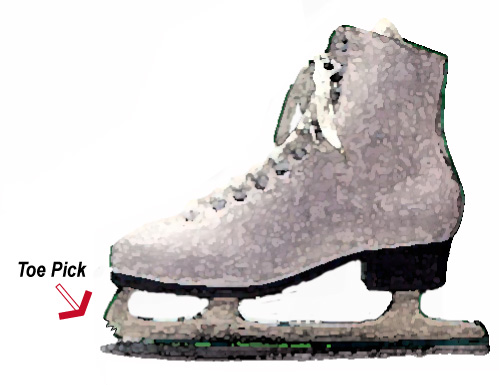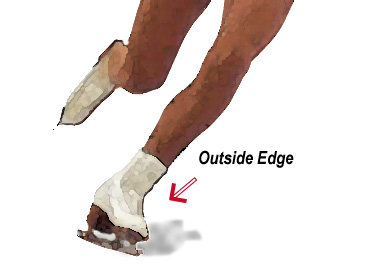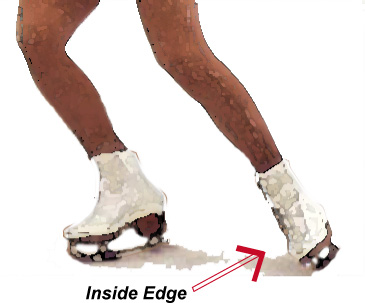3. LEARN ABOUT THE JUMPS
Many people who watch figure skating on TV simply see a skater fling himself/herself into the air, twist a couple times, and land backwards on one skate. But all the jumps look kinda the same . . . what makes one jump more difficult than another? Glad you asked, because we've already written out the answers.
In figure skating, there are two basic kinds of jumps:
- Toe Jump - this is when the skater uses the toe pick (the tiptoe of the skate) of one skate to vault up in the air
- Edge Jumps - this is when the skater takes off from a specific edge of a skate without the benefit of help from the other skate. A toe pick push-off isn't allowed.
When talking about edges, skaters get very specific, saying things like "left back outside edge." In order to understand the edge terminology, you just need to break that statement down. "Left" refers to the foot . . . so there can be right and left edges. "Back" refers to the part of the blade near the heel, while a "Forward" edge is the part near the toe. "Outside" refers to the side of the blade facing away from the other leg. We hope that "Inside" would then be self-explanatory.



The skaters you see on television all have about six jumps in their repertoires - Toe Loop, Flip, Lutz, Salchow (pronounced "sow-cow"), Loop, and Axel. A single, double, triple or quadruple jump refers to how many times the skater spins in the air between the takeoff and landing. Finally, these jumps can be done in combinations, meaning that two jumps are done right in a row, without any extra steps taken in between.
Toe Jumps
Toe Loop The easiest toe jump is called the Toe Loop. To perform a Toe Loop, the skater glides backward on the outside edge of the right skate, jabs the left toe pick into the ice, and then rotates to the left. Because this jump is so easy (just jab the toe pick into the ice and jump), it is often done as the second half of a combination. The second-easiest toe jump is called the Flip. The Flip looks a whole lot like the Toe Loop; the only difference is that the skater glides backward on the inside edge of the left skate and toe picks with the right foot to start the leftward rotation. One hint about spotting a Flip is the entrance. Most skaters start by gliding forward in a straight line on the left foot with the arms out and the right leg up in front. The right leg then taps the ice as the skater rotates ½ a turn to the left so that he/she is traveling backward. The right leg is still elevated, which is good because it is needed to hit the ice to start the rotation. Now on to the Lutz ... Being able to identify the entrance to a jump is perhaps most helpful with the Lutz because it is so similar to the Flip. Like the Flip, the Lutz uses the right toe pick to vault the skater off of his left leg. The difference is that the Lutz uses the left outside edge instead of the inside. This slight shift of weight makes this jump much more difficult and in fact, one way to cheat the Lutz is to switch to an inside edge at the last second (this is called a Flutz, since it is really a Flip disguised as a Lutz). The entrance of the Lutz is what makes it easy to identify. Skaters typically do their Lutzes in the corner of the rink after taking a long glide on a curving diagonal to set up the proper edge.Edge Jumps
Salchow The Salchow is named after Ulrich Salchow, a skater from the early 1900s. This jump takes off from the left back inside edge. Typically, the skater turns counterclockwise on the ice, standing on the left leg, settles into that left back inside edge, and then scoops the right leg up and over the left to initiate the jump rotation. Being able to swing the right leg around to gather momentum helps to make this the easiest of the edge jumps. The Loop (not to be confused with the Toe Loop) is one of the most difficult jumps, edge or toe, because the right thigh has to do all the work without any help from a toe pick or a swinging free leg. In this jump, the skater starts by skating backwards on two feet, with the left foot crossed in front of the right. Then, the skater simply (yeah right) springs off of the right back outside edge, keeping the feet crossed, and rotates to the left. The Axel is probably the most identifiable of all of the jumps because it is the only one with a forward takeoff. In all of the other jumps, the skater both starts and ends gliding backwards but the Axel takes off from the left front outside edge. Since it ends backward like all the others, a triple Axel is actually 3 ½ rotations, making it more difficult than the other triples.The only jumps Eligible skaters intentionally do as doubles are the Axel and the Toe Loop, or Loop if it comes as the second half of a combination. Otherwise, all jumps are supposed to be triples or quads. If you see a skater perform a double Lutz, for example, you know that he or she has just made a big mistake and the First Mark (the technical score) will take a hit.
Oh, one more thing: when the skaters spin in midair during a jump, they can turn clockwise or counterclockwise. Most skaters rotate counterclockwise (which is a trait of right-handedness), so that's how we described everything above. If you are dying to know how a clockwise skater might go about one of these moves, simply change the words "right" and "left" and you'll be all set. Either that or take it up with your local chapter of Left-handed Elitists For Triumph (L.E.F.T.).
Now, you can read about the Jumps all day long. But to truly learn the jumps, you need to watch a professional and then practice on the ice. check out these figure skating videos on ehow.com. You can learn how to do almost anything by watching the videos on ExpertVillage.
Illustrations proivided by Julie Yu Chin Liu and are 2000, SoYouWanna.net, Inc.

